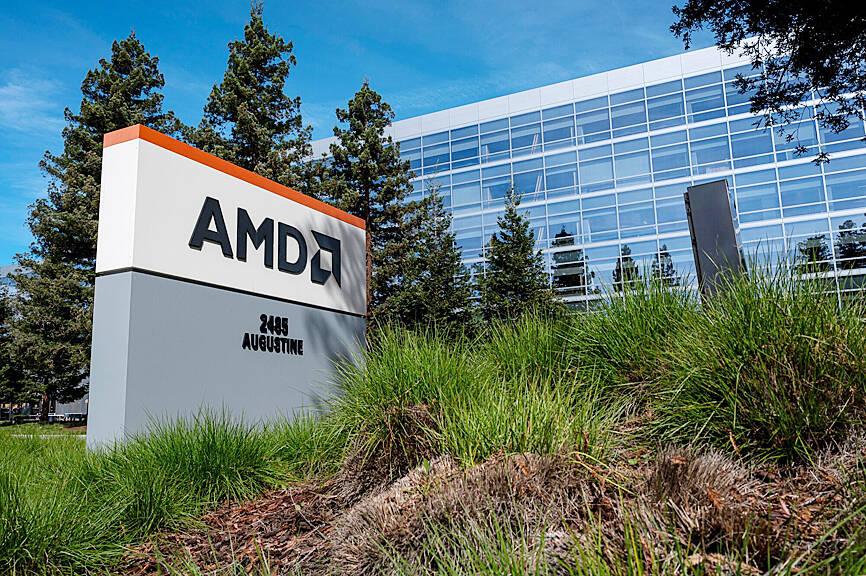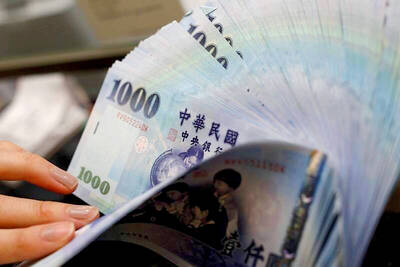Advanced Micro Devices Inc (AMD) slid in late trading yesterday after the chipmaker’s revenue forecast missed analysts’ estimates, a sign its artificial intelligence (AI) sales are growing more slowly than some had anticipated.
Revenue will be roughly US$7.5 billion in the fourth quarter, the company said yesterday. Analysts estimated US$7.55 billion on average.
Though the company now expects to get more than US$5 billion in sales from so-called AI accelerators this year — up from a previous forecast of US$4.5 billion — some analysts and investors had been looking for a bigger bump.

Photo: Bloomberg
AMD is playing catch-up with Nvidia Corp in the lucrative market for these chips, which help develop and run AI services. The company is now generating billions of dollars from that type of product — a rapid rise from a year ago — but the level remains well short of the tens of billions of dollars that its rival is raking in.
On a conference call following the results, AMD chief executive officer Lisa Su (蘇姿丰) pushed back on concerns that AMD isn’t delivering enough growth. The company is ramping up production and earning the trust of the large data center companies that rely on AI accelerators, she said.
“What I will say is customers are very, very open to AMD,” Su said. “And we see that everywhere we go. Everyone is giving us a very fair shot at earning their business, and that’s what we intend to do.”
AMD shares fell more than 7 percent in late trading. They were up 13 percent this year, closing at US$166.25 in New York.
AMD’s third-quarter revenue rose 18 percent year-on-year to US$6.82 billion, beating an average estimate of US$6.71 billion. Profit, minus certain items, increased to US$0.92 a share, in line with projections.
AMD’s new MI300 accelerator products, which compete with Nvidia chips, have emerged as one of its biggest sales engines. But the growth has been hampered by the availability of supply. Like most companies in the industry, AMD no longer owns its own plants, opting instead to outsource production to Taiwan Semiconductor Manufacturing Co (台積電).
The company has made progress in getting more supply from its vendors, but still expects to have little latitude in terms of meeting demand if it’s above current projections, Su said on the call.
“I think we expect that the environment will continue to be tight, but we’ve also planned for significant growth going into 2025,” Su said. “We feel good about our overall supply-chain capability.”
Investors track AMD’s performance as an indicator of overall demand for AI-related hardware. Massive spending by companies such as Amazon.com Inc’s AWS and Microsoft Corp on this still-new type of computing infrastructure has upended the industry. The concern among investors is that AI services aren’t yet big moneymakers, which may make it harder for companies to continue justifying the expense of buying the chips.
In addition to being Nvidia’s biggest rival in AI accelerators, AMD also competes with that company in graphics chips used by computer gamers. It also goes head-to-head with Intel Corp in PC and server processors.
AMD’s data center unit had sales of US$3.5 billion last quarter, more than double the total from a year earlier and slightly above estimates. PC chips brought in US$1.88 billion, up 29 percent.
AMD also supplies custom processors for Microsoft and Sony Group Corp for their game consoles. That unit has seen weaker sales, hurt by the current generation of game machines nearing the end of their life cycles. Revenue fell 69 percent year-on-year to US$462 million, missing estimates.

Merida Industry Co (美利達) has seen signs of recovery in the US and European markets this year, as customers are gradually depleting their inventories, the bicycle maker told shareholders yesterday. Given robust growth in new orders at its Taiwanese factory, coupled with its subsidiaries’ improving performance, Merida said it remains confident about the bicycle market’s prospects and expects steady growth in its core business this year. CAUTION ON CHINA However, the company must handle the Chinese market with great caution, as sales of road bikes there have declined significantly, affecting its revenue and profitability, Merida said in a statement, adding that it would

i Gasoline and diesel prices at fuel stations are this week to rise NT$0.1 per liter, as tensions in the Middle East pushed crude oil prices higher last week, CPC Corp, Taiwan (台灣中油) and Formosa Petrochemical Corp (台塑石化) said yesterday. International crude oil prices last week rose for the third consecutive week due to an escalating conflict between Israel and Iran, as the market is concerned that the situation in the Middle East might affect crude oil supply, CPC and Formosa said in separate statements. Front-month Brent crude oil futures — the international oil benchmark — rose 3.75 percent to settle at US$77.01

RISING: Strong exports, and life insurance companies’ efforts to manage currency risks indicates the NT dollar would eventually pass the 29 level, an expert said The New Taiwan dollar yesterday rallied to its strongest in three years amid inflows to the nation’s stock market and broad-based weakness in the US dollar. Exporter sales of the US currency and a repatriation of funds from local asset managers also played a role, said two traders, who asked not to be identified as they were not authorized to speak publicly. State-owned banks were seen buying the greenback yesterday, but only at a moderate scale, the traders said. The local currency gained 0.77 percent, outperforming almost all of its Asian peers, to close at NT$29.165 per US dollar in Taipei trading yesterday. The

RECORD LOW: Global firms’ increased inventories, tariff disputes not yet impacting Taiwan and new graduates not yet entering the market contributed to the decrease Taiwan’s unemployment rate last month dropped to 3.3 percent, the lowest for the month in 25 years, as strong exports and resilient domestic demand boosted hiring across various sectors, the Directorate-General of Budget, Accounting and Statistics (DGBAS) said yesterday. After seasonal adjustments, the jobless rate eased to 3.34 percent, the best performance in 24 years, suggesting a stable labor market, although a mild increase is expected with the graduation season from this month through August, the statistics agency said. “Potential shocks from tariff disputes between the US and China have yet to affect Taiwan’s job market,” Census Department Deputy Director Tan Wen-ling